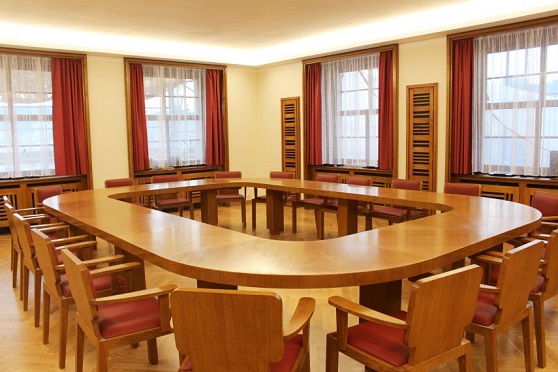
Other parts of the town hall in Jablonec have been returned to their original form
 |
| Reconstructed meeting room No. 203, photo: www.mestojablonec.cz |
Jablonec nad Nisou - Other parts of the historic town hall in Jablonec nad Nisou have returned to their original appearance from the 1930s. The city is gradually removing the unsightly formica and particle board cladding used during the insensitive reconstruction in the 1970s, restoring the design proposed by architect Karel Winter. The restoration of two meeting rooms, which cost nearly three million crowns, has now been completed, said Marek Řeháček, the secretary of the magistrate, to ČTK today.
A significant benefit during the restoration was that many valuable wooden elements were preserved under the formica cladding. Conservators uncovered the original doors that connected the large council chamber with the adjacent small meeting room. "This is a positive finding for hall 202 (the council chamber) as many wooden elements were preserved even after the pseudorestorations. Fortunately, they were just covered, meaning that even the chairman's table was clad in formica, but the original is underneath," noted Řeháček.
The small meeting rooms now have new parquet floors, as the old ones were infested with wood rot. "All the walls were covered with formica up to the height of the upper cornice; the ventilation grids, where the air conditioning originally ran, were not visible, and the radiator grids were not here, the entire doors were covered with formica," described the original condition of both rooms Jan Hrdina from the Brno restoration studio R-Atelier. According to him, it was sometimes detective work, as the town hall plans were preserved only about 60 percent, and some details were missing. For example, the height of the ventilation grids was inferred by craftsmen from remnants of plaster and preserved parts of the lintels.
The original doors and wooden window cladding along with radiator grills are restored in the renovated halls, and one of them even features the original oval wooden table. "The chairs did not survive, so we had new ones made according to architect Winter's designs," said the secretary. According to the original designs, the town hall also commissioned a chandelier that had not been funded during the construction of the town hall in the 1930s. The chandelier, made of bronze and glass and weighing 80 kilograms, was produced by the company Houska and Douda. Including two wall lamps, it cost about half a million crowns.
The Jablonec town hall is an important building of Czechoslovak interwar architecture. It was built between 1931 and 1933 according to the design of architect Karel Winter. The monument-protected building is being gradually restored by the city, which has invested over 35 million crowns in it over the past six years, with this year's repairs costing an additional 15 million crowns. The city is gradually having the windows, facade, and interiors repaired. The main council chamber is scheduled for reconstruction next year. According to Řeháček, the preliminary costs are estimated at five to seven million crowns.
The English translation is powered by AI tool. Switch to Czech to view the original text source.
0 comments
add comment
Related articles
0
14.06.2019 | Work on the restoration of the town hall facade in Jablonec will be completed during the holidays
0
03.07.2018 | After a three-year break, the tower of the town hall in Jablonec will be accessible
0
11.05.2018 | Jablonec nad Nisou has prepared a record investment of 351 million CZK this year
0
19.12.2017 | The largest meeting hall of the town hall in Jablonec will regain its original form
0
16.11.2017 | The repair of the town hall facade in Jablonec will extend into next year
0
04.08.2017 | Renovation of the town hall in Jablonec continues inside the historic building
0
05.06.2017 | The repair of the town hall tower in Jablonec nad Nisou will be extended until October
0
17.04.2017 | The repair of the town hall tower in Jablonec nad Nisou will again limit parking
0
06.09.2016 | The repair of the town hall in Jablonec will be extended
2
11.01.2008 | Jablonec is preparing for the reconstruction of the town hall building










